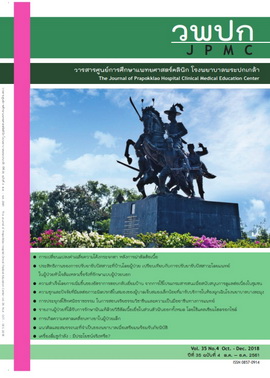Success of an increase in home visit care response rates by using information programs to continuous of care
Main Article Content
Abstract
Background: The spread of digital technologies has resulted in enormous changes in society and healthcare systems, causing emerging patterns of activities in all sectors including home visit care. In the past, patient data was transferred from hospitals to community healthcare personnel by paper, which resulted in home visit rates of only 11 - 13%. Thus, development of an information system by linking the hospital patient data to community healthcare personnel by a Smart Continuum of Care (Smart COC) program can improve the quality and the rate of home visits.
Objective: To study the effects of using the Smart COC program on the response rate of patient home visits.
Materials and method: A descriptive study collected data of all patients who were discharged from the hospital and needed home visit feedback from community healthcare personnel that made patient home visits through the Smart COC program from February 1, 2014 until July 31, 2016. The Smart COC program was used through www.smartcoc.info. This program operates as an Internet-based application that can be used by any type of smartphone, which processes the data of patients from the hospital directly to the Smart COC program. The data of this process was collected and evaluated according to the Key Performance Index.
Results: There are 1,151 service units with 3,017 users using the Smart COC program. Based on the patient data, 113,711 patients out of 124,399 patients (93.9%) received home visits by medical personnel and 44.0% were visited within 14 days after discharge. The patient data revealed symptom improvement in 72.7% and stable disease in 32.1%. Only 0.1% of patients were found to have complications. It was also found that 3,254 patients (2.8%) died at home, most of whom were palliative care patients.
Conclusion: The Smart COC program is convenient and useful in managing and transferring patient data from hospitals to community healthcare personnel within a second, resulting in an increase in patient home visits and improved quality of care.
Article Details
References
1. Ministry of Industry. Thai industrial development Strategy 4.0 period 20 years (2017-2036). Bangkok: Ministry of Industry; 2016.
2. Office of the National Economic and Social Development Board.11th National Economic and Social Development Plan 2012 – 2016. Bangkok: NESDB; 2011.
3. Institute for Population and Social Research, Mahidol University. Thai people health 2016. Bankkok : Amarin Printing & Publishing; 2016.
4. Office of the National Economic and Social Development Board. 12thNational Economic and Social Development Plan 2017 – 2021. Bangkok: NESDB; 2016.
5. Office of the National Economic and Social Development Board. Directions of the National Economic and Social Development Plan No.12, 2016 - 2020. Bangkok : NESDB; 2016.
6. Ministry of Public Health. Situation Report NCDs No. 2. Nonthaburi : International Health Policy Development Office; 2016.
7. Office of the Prime Minister. Twenty-years national strategic plan (2017-2036). Bangkok: NESDB; 2016.
8. Ministry of Public Health. Position, vision, mission, goals Values and Strategies of the Ministry of Public Health. Nonthaburi: Office of Policy and Strategy Office of the Permanent Secretary; 2016.
9. Bundhamcharoen K, Sasat S. Long-term care system : comparative analysis for
policy recommendation. Rama Nurs J 2008;3:385-99.
10. Holzemer WL. The impact of nursing care in Latin America and the Caribbean: a focus on outcomes. J Adv Nurs 1994;20:5-12.
11. Williams SL, Haskard KB, DiMatteo MR. The therapeutic effects of the physician-older patient relationship: effective communication with vulnerable older patients. ClinInterv Aging 2007;2:453-67.

